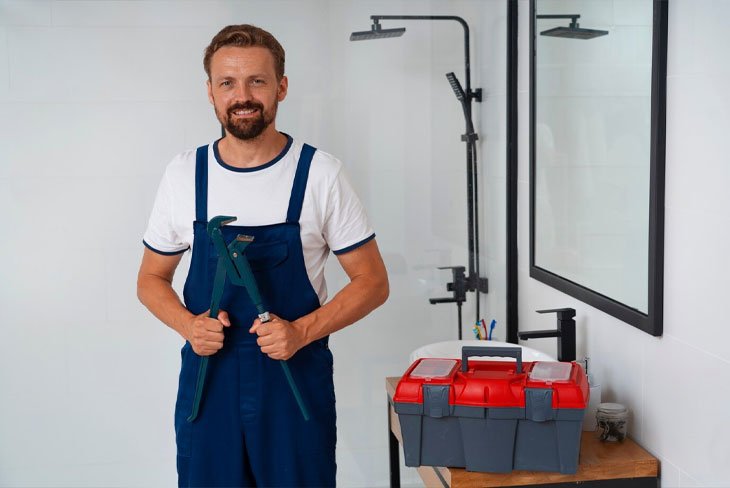Do unexpected plumbing bills drain your wallet? Many homeowners face this challenge, but you can keep your pipes flowing smoothly without breaking the bank. This article explores practical strategies to reduce plumbing costs while maintaining quality and efficiency in your home’s water systems.
Plumbing services are necessary expenses for property owners. These services ensure clean water enters homes and wastewater exits safely. Plumbing expenses can add up quickly, especially during emergencies. From simple leaks to major pipe repairs, plumbing expenditures range from $180 to $494 for most homeowners, with the average cost reaching $336 per service call.
You can save money on professional plumbing assistance without compromising quality. By implementing regular maintenance, tackling simple DIY repairs, hiring the right professionals, practicing water conservation measures, and choosing appropriate fixtures, homeowners can significantly lower service expenses.
This article guides you through these cost-effective solutions, helping you maintain healthy water system care while keeping your budget intact.
Regular Maintenance
Regular maintenance forms the cornerstone of healthy water system maintenance. It prevents minor issues from becoming major problems, saving homeowners substantial amounts in expensive plumbing repairs. By investing time and effort in routine checks, property owners avoid costly emergency repairs and extend plumbing fixtures.
Affordable maintenance offers early detection of potential issues. Small leaks, slow drains, or unusual noises indicate underlying problems. When caught early, these issues cost little to fix. Left unattended, they lead to water damage, pipe corrosion, or complete system failures, resulting in hefty repair bills.
Perform regular maintenance with these simple steps:
- Inspect visible pipes for leaks or corrosion
- Check faucets and showerheads for drips or reduced water flow
- Test all toilets for proper flushing and potential leaks
- Clean drain stoppers and remove visible debris from drains
- Examine water heater connections and settings
Incorporating these tasks into monthly or quarterly routines keeps plumbing systems in top condition and prevents unnecessary expenses.
DIY Repairs
While some plumbing issues require professional expertise, many common problems can be resolved through DIY repairs. Tackling minor issues yourself saves significant money on service charges and labor costs. Know your limits and recognize when jobs exceed your skills to avoid causing further damage.
Plumbing tasks often suitable for DIY include:
- Unclogging drains
- Fixing leaky faucets
- Replacing showerheads
- Adjusting toilet components
Invest in basic plumbing tools for safe, effective fixture maintenance:
- Plunger
- Adjustable wrench
- Pipe wrench
- Plumber’s tape
- Drain snake
When attempting DIY repairs, always turn off the water supply to affected areas before starting work. Research repair processes thoroughly and follow instructions carefully. If you encounter unexpected complications or feel unsure, stop and consult a professional plumber.
Hiring a Plumber
While DIY repairs save money on minor issues, there are times when hiring professional plumbers becomes necessary. Complex problems like sewer line repairs or major pipe replacements require specialized knowledge and equipment. Attempting DIY repairs on complex systems leads to more extensive damage and higher costs.
Find reliable and affordable plumbers with these steps:
- Ask for recommendations from friends, family, or neighbors
- Check online reviews and ratings from previous customers
- Verify licenses and insurance coverage
- Get multiple quotes for comparison
- Ask about flat-rate pricing versus hourly rates
When working with plumbers, clear communication maximizes value for your money. Describe problems in detail and ask for written estimates before work begins. Ask questions about proposed solutions and any alternative options that might be more budget-friendly.
Maximize plumber visit value by bundling multiple small jobs into one service call. This approach proves more efficient and cost-effective than scheduling separate appointments for each issue.
Water Conservation
Water conservation measures serve both environmental and practical purposes, saving money on plumbing services. Reducing water usage lowers water bills and decreases strain on plumbing systems, potentially extending pipe and fixture life.
Effective ways to conserve water in your home:
- Fix leaks promptly: Even small leaks waste significant water over time
- Install low-flow fixtures: These reduce usage without compromising functionality
- Use water-efficient appliances: Look for Energy Star-certified dishwashers and washing machines
- Collect rainwater: Use it for watering plants or cleaning outdoor areas
- Take shorter showers: Reducing shower time by a minute saves gallons of water
Implementing these water-efficient retrofitting techniques leads to substantial savings on water bills. Using less water means less wear and tear on plumbing systems, potentially reducing repair and replacement frequency.
Plumbing Fixtures
Choosing plumbing fixtures significantly impacts both water usage and long-term maintenance costs. Selecting high-quality, efficient fixtures requires a larger upfront investment but results in considerable savings over time.
When choosing plumbing fixtures, consider these factors:
- Water efficiency: Look for WaterSense-labeled products meeting EPA criteria for water efficiency
- Durability: Choose fixtures made from high-quality materials that withstand frequent use
- Ease of maintenance: Select fixtures with easily replaceable parts and simple cleaning requirements
- Compatibility: Ensure new fixtures work with existing plumbing systems
Here’s a comparison of water usage for standard versus efficient fixtures:
| Fixture Type | Standard Usage | Efficient Usage | Potential Savings |
|---|---|---|---|
| Toilet | 3.5 gal/flush | 1.28 gal/flush | 63% per flush |
| Showerhead | 2.5 gpm | 2.0 gpm | 20% per minute |
| Faucet | 2.2 gpm | 1.5 gpm | 32% per minute |
(gal = gallons, gpm = gallons per minute)
Proper installation of plumbing fixtures ensures optimal performance and longevity. While some homeowners feel confident installing simple fixtures like faucets or showerheads, more complex installations (such as toilets or water heaters) are often best left to professionals to ensure proper function and avoid potential water damage.
Conclusion
Saving money on plumbing services is achievable through proactive maintenance, smart DIY repairs, careful professional selection, water conservation measures, and choosing the right fixtures. By implementing these strategies, homeowners maintain healthy plumbing systems while controlling costs.
Regular maintenance catches issues early, preventing costly emergencies. DIY repairs for minor problems save on service calls, while knowing when to hire professionals ensures complex issues get handled correctly. Water conservation measures reduce strain on plumbing systems and lower utility bills. Selecting efficient fixtures leads to long-term savings on both water usage and maintenance costs.
Taking a proactive approach to property upkeep allows homeowners to enjoy reliable water systems without worrying about unexpected, budget-busting repairs. When it comes to plumbing, prevention truly proves worth more than cure.




No Comment! Be the first one.